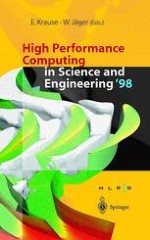1999 | OriginalPaper | Chapter
The interplay between d-wave superconductivity and antiferromagnetic fluctuations: a quantum Monte Carlo study
Author : F. F. Assaad
Published in: High Performance Computing in Science and Engineering ’98
Publisher: Springer Berlin Heidelberg
Included in: Professional Book Archive
Activate our intelligent search to find suitable subject content or patents.
Select sections of text to find matching patents with Artificial Intelligence. powered by
Select sections of text to find additional relevant content using AI-assisted search. powered by
We consider the repulsive Hubbard model on a square lattice with an additional term, W, which depends upon the square of a single-particle nearest-neighbor hopping. At half-band filling, constant W, we show that enhancing U/t drives the system from a d-wave superconductor to an antiferromagnetic Mott insulator. At zero temperature in the superconducting phase, spin-spin correlations follow a powerlaw: e-ir.Q|r|-α. Here Q= (π,π) and α is in the range 1 < α < 2 and depends upon the coupling constants W and U. This results is reached on the basis of large scale quantum Monte-Carlo simulations on lattices up to 24 × 24, and is shown to be independent on the choice of the boundary conditions. We define a pairing (magnetic) scale by the temperature below which short range d-wave pairing correlations (antiferromagnetic fluctuations) start growing. With finite temperature quantum Monte Carlo simulations, we demonstrate that both scales are identical over a large energy range. Those results show the extreme compatibility and close interplay of antiferromagnetic fluctuations and d-wave superconductivity.The understanding of the interplay between d-wave superconductivity and antiferromagnetism is a central issue for the understanding of the phase diagram of High-T c superconductors [1]. The aim of this work is to further study a model which shows a quantum transition between a d-wave superconductor and an antiferromagnetic Mott insulator. It thus enables us to address the above question. The model we consider, has been introduced in Ref. [2]. It is defined by: 1$$ H = - \frac{t}{2}\sum\limits_i {{K_i}} - W\sum\limits_i {K_i^2} + U\sum\limits_i {\left( {{n_{i, \uparrow }} - \frac{1}{2}} \right)} \left( {{n_{i, \downarrow }} - \frac{1}{2}} \right) $$ with the hopping kinetic energy 2$${{K}_{i}} = \sum\limits_{{\sigma ,\delta }} {(c_{{i,\sigma }}^{\dag }{{c}_{{i + \delta ,\sigma }}} + c_{{i + \delta ,\sigma }}^{\dag }{{c}_{{i,\sigma }}})}$$ Here, W ≥ 0, δ = ±a x , ±a y , and n i,σ = c i,σ †c i,σ where c i,σ †(c i,σ ) creates (annihilates) an electron on site i with z-component of spin σ. We impose twisted boundary conditions: 3$$ {c_{i + L{a_x},\sigma }} = \exp \left( {2\pi i\Phi /{\Phi _0}} \right){c_{i,\sigma }},{c_{i + L{a_y},\sigma }} = {c_{i,\sigma }} $$We have equally shown that the energy scales at which d-wave pairing and antiferromagnetic fluctuations occur are identical. The further understanding of spin and charge dynamics, as well as the doping of the model remains for further studies.
